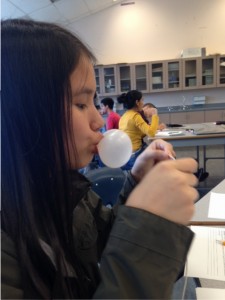Problem A:
Gum B (Big League Chew) proved to have the superior bubble blowing capabilities, thus disproving our hypothesis that Gum A would produce the largest bubble, due to its tougher consistency. Gum B’s bubbles were an average of 13.3 cm larger than Gum A’s, and the time needed to chew the hum to produce the bubble was significantly shorter than Gum A.
Both:
Our initial hypotheses stated that Gum A would prove to be the better gum, as it had a tougher dexterity/consistency than Gum B, and it was thought that this feature would help [the gum] sustain more pressure, such as air and physical stress, than its counterpart. However, this proved to be false as Gum B’s loose, powdery consistency turned out to be superior when it comes to blowing bubbles and stretching the gum itself.
The data we collected can be described as both qualitative and quantitative, as we measured the quality of the gum (how much stress the gum can sustain) and the quantity of volume of the blown bubbles (measured the area that each bubble takes up).
SI units were used in the lab (grams, seconds).
Five variables that my have affected the outcome of this experiment:
- Time spent chewing the gum.
- Contents of the saliva of the Chewer (based on what they ate, how many liquids have been consumed, etc..)
- Time the gum was exposed to the atmosphere of the lab (chewed Gum B was exposed for less time than Gum A)
- Faults in measuring (human error)
- Unknown amount of influence of the act of practicing blowing bubbles (the theory that the more bubbles blown, the bigger they will get)
The Test Subject (aka the Chewing Gum Inflation Device aka CGID aka Chloe)

